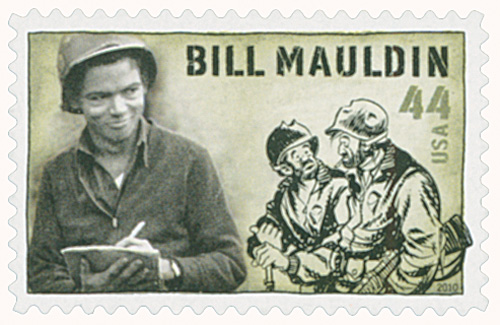
# 4445 - 2010 44c Bill Mauldin
Birth of Bill Mauldin
The son of a World War I veteran, Mauldin spent his childhood in Mountain Park and later Phoenix, Arizona. He then went on to attend the Chicago Academy of Fine Arts. Mauldin returned to Phoenix in 1940 and enlisted in the Arizona National Guard.
Two days after his enlistment, his guard unit, the 45th division, was nationalized. Mauldin then volunteered to work for the unit’s newspaper. During this time he drew cartoons about regular soldiers (called dogfaces) and developed two cartoon characters, Willie and Joe, who represented the average American GI.
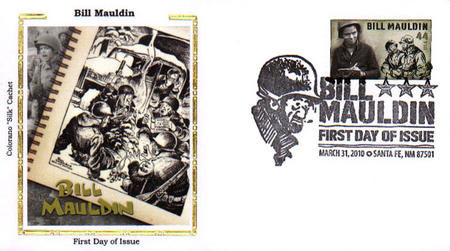
In July 1943, Mauldin was shipped to Sicily. He continued to work on his cartoons for the 45th Division’s paper and also started working for the Army newspaper, Stars and Stripes. In February 1944, he was officially transferred to Stars and Stripes. That March, he was given his own Jeep, so he could travel around the front to collect material. Although he covered fighting in Salerno, Sicily, and other locations throughout Italy, France, and Germany, he is best remembered for Willie and Joe.
Mauldin would publish six cartoons a week. Soldiers stationed throughout Europe as well as citizens back home in the US viewed his cartoons. The War Office also supported the syndication of Mauldin’s cartoons because they publicized the ground forces and also showed the grimness of the war, so the public would see that winning the war wouldn’t be easy.
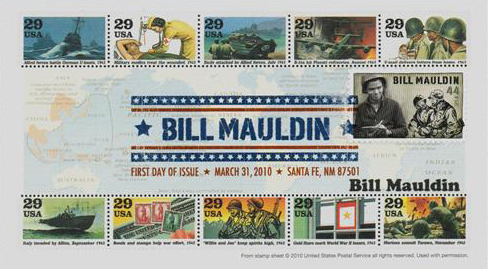
Willie and Joe were based on the everyday infantryman and accurately portrayed the plight of the World War II combat soldier. Unshaven, wet, exhausted and dirty, Willie and Joe survived the war by mocking everything from their orders and equipment to the top brass. Keeping their spirits high, this disheveled pair helped many soldiers caught up in the horrors of war keep their sense of humor.
Mauldin’s popular cartoons famously inspired the wrath of General George Patton. In one cartoon, Mauldin poked fun at Patton’s decree that all soldiers be clean-shaven at all times. Patton claimed Mauldin was an “unpatriotic anarchist,” threatened to throw him in jail, and ban Stars and Stripes from his command. However, Patton’s superior, Dwight Eisenhower, told him that the cartoons helped to relieve the soldiers’ stress and that they shouldn’t interfere.
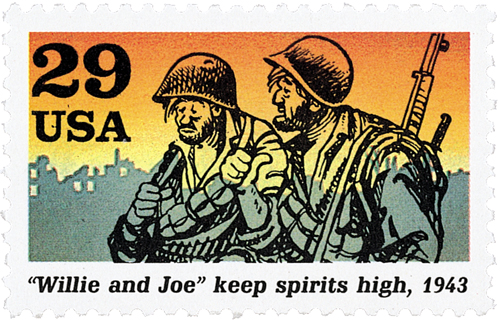
Mauldin was popular among soldiers for his cartoons. And his credibility increased in September 1943 when he was wounded in the shoulder by German fire while visiting a gun crew near Monte Cassino. He received a Purple Heart for that injury and later the Army’s Legion of Merit for his cartoons. Mauldin wanted to kill Willie and Joe on the last day of combat, but the newspaper convinced him not to.
In 1945, Mauldin, at age 23, was awarded the Pulitzer Prize for his work during the war. He was the youngest individual ever honored. After the war was over, Willie and Joe continued to give enlisted men a laugh as they accurately pictured the soldier’s difficult transition back to civilian life.
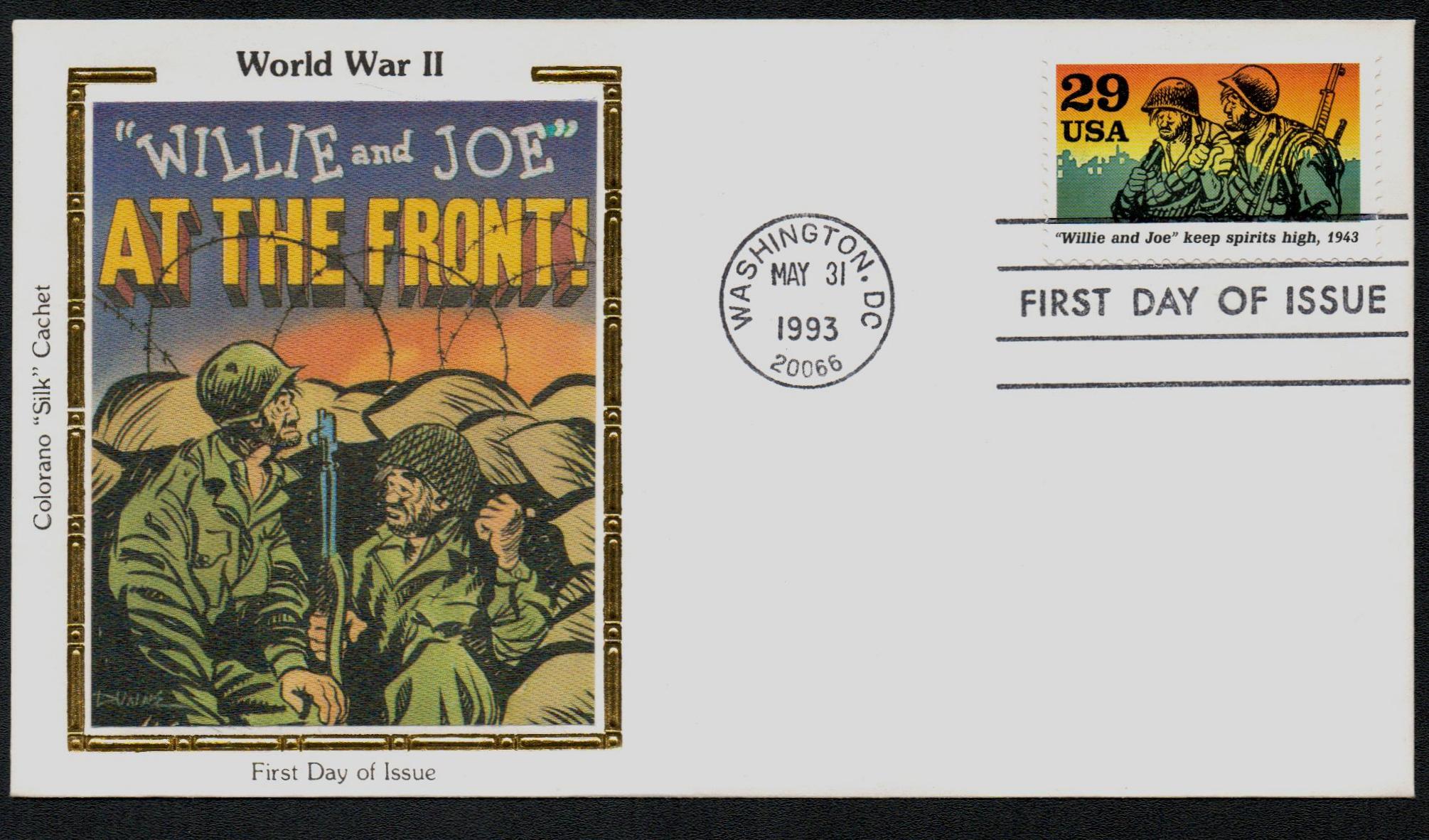
Mauldin collected his cartoons in a book which also included his observations of the war. The book was a best seller in 1945. That year Willie was also featured on the cover of Time Magazine. Mauldin would be featured on the cover in 1961.
In the years after the war, Mauldin turned to drawing political cartoons, which earned him a second Pulitzer Prize in 1959. One of Mauldin’s most famous cartoons pictures Abraham Lincoln’s statue weeping after John F. Kennedy’s assassination, again reflecting the feelings of the common man. In 1985 he won the Walter Cronkite Award for Excellence in Journalism. And in 1998, he drew Willie and Joe one last time for a Veterans Day Peanuts comic strip.
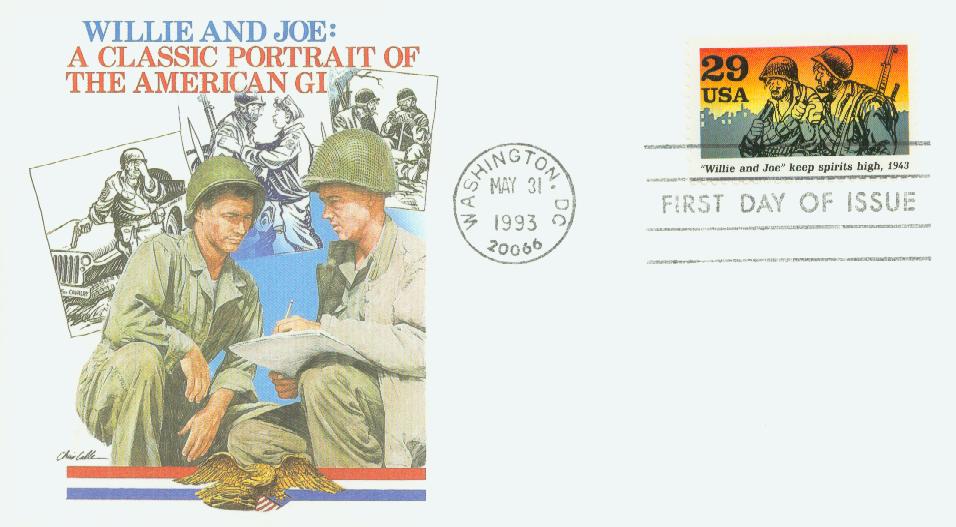
In his later years, Mauldin developed Alzheimer’s. During his last years in a nursing home, he received thousands of letters from veterans showing the impact his cartoons had on them: “You… managed to capture the irony, double standards and outright insanity of Army life… in a way that allows us to laugh at ourselves and our leaders and keep moving in the face of adversity.” Mauldin died on January 22, 2003.
Click here for more about Mauldin’s life and his cartoons.
Birth of Bill Mauldin
The son of a World War I veteran, Mauldin spent his childhood in Mountain Park and later Phoenix, Arizona. He then went on to attend the Chicago Academy of Fine Arts. Mauldin returned to Phoenix in 1940 and enlisted in the Arizona National Guard.
Two days after his enlistment, his guard unit, the 45th division, was nationalized. Mauldin then volunteered to work for the unit’s newspaper. During this time he drew cartoons about regular soldiers (called dogfaces) and developed two cartoon characters, Willie and Joe, who represented the average American GI.

In July 1943, Mauldin was shipped to Sicily. He continued to work on his cartoons for the 45th Division’s paper and also started working for the Army newspaper, Stars and Stripes. In February 1944, he was officially transferred to Stars and Stripes. That March, he was given his own Jeep, so he could travel around the front to collect material. Although he covered fighting in Salerno, Sicily, and other locations throughout Italy, France, and Germany, he is best remembered for Willie and Joe.
Mauldin would publish six cartoons a week. Soldiers stationed throughout Europe as well as citizens back home in the US viewed his cartoons. The War Office also supported the syndication of Mauldin’s cartoons because they publicized the ground forces and also showed the grimness of the war, so the public would see that winning the war wouldn’t be easy.

Willie and Joe were based on the everyday infantryman and accurately portrayed the plight of the World War II combat soldier. Unshaven, wet, exhausted and dirty, Willie and Joe survived the war by mocking everything from their orders and equipment to the top brass. Keeping their spirits high, this disheveled pair helped many soldiers caught up in the horrors of war keep their sense of humor.
Mauldin’s popular cartoons famously inspired the wrath of General George Patton. In one cartoon, Mauldin poked fun at Patton’s decree that all soldiers be clean-shaven at all times. Patton claimed Mauldin was an “unpatriotic anarchist,” threatened to throw him in jail, and ban Stars and Stripes from his command. However, Patton’s superior, Dwight Eisenhower, told him that the cartoons helped to relieve the soldiers’ stress and that they shouldn’t interfere.

Mauldin was popular among soldiers for his cartoons. And his credibility increased in September 1943 when he was wounded in the shoulder by German fire while visiting a gun crew near Monte Cassino. He received a Purple Heart for that injury and later the Army’s Legion of Merit for his cartoons. Mauldin wanted to kill Willie and Joe on the last day of combat, but the newspaper convinced him not to.
In 1945, Mauldin, at age 23, was awarded the Pulitzer Prize for his work during the war. He was the youngest individual ever honored. After the war was over, Willie and Joe continued to give enlisted men a laugh as they accurately pictured the soldier’s difficult transition back to civilian life.

Mauldin collected his cartoons in a book which also included his observations of the war. The book was a best seller in 1945. That year Willie was also featured on the cover of Time Magazine. Mauldin would be featured on the cover in 1961.
In the years after the war, Mauldin turned to drawing political cartoons, which earned him a second Pulitzer Prize in 1959. One of Mauldin’s most famous cartoons pictures Abraham Lincoln’s statue weeping after John F. Kennedy’s assassination, again reflecting the feelings of the common man. In 1985 he won the Walter Cronkite Award for Excellence in Journalism. And in 1998, he drew Willie and Joe one last time for a Veterans Day Peanuts comic strip.

In his later years, Mauldin developed Alzheimer’s. During his last years in a nursing home, he received thousands of letters from veterans showing the impact his cartoons had on them: “You… managed to capture the irony, double standards and outright insanity of Army life… in a way that allows us to laugh at ourselves and our leaders and keep moving in the face of adversity.” Mauldin died on January 22, 2003.
Click here for more about Mauldin’s life and his cartoons.












